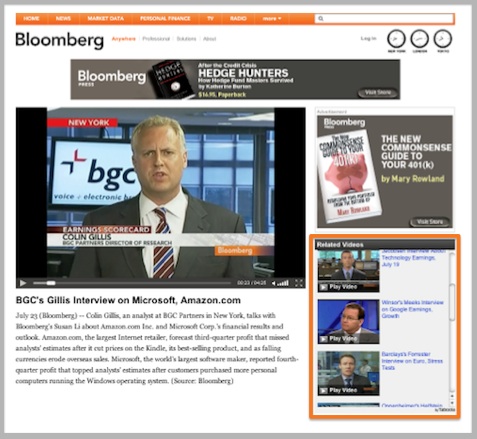-
Bloomberg is Now Using Taboola's Video Recommendations
Browsing the web last week, I noticed that Bloomberg.com is now incorporating videos throughout its site from Taboola, the video recommendations engine. If you click on any article on the site, in the lower part of the right column you'll see several thumbnails of recommended videos (here's an example from an article today about Motorola's earnings). When you click any video you're then brought to a playback page, which has additional recommended videos (see below).
Earlier this week I spoke to Adam Singolda, Taboola's CEO and founder, to learn more about the Bloomberg deal and catch up on progress since I last wrote about Taboola. On Bloomberg's video playback pages it is using Taboola's initial product, which is called Video2Video. Taboola uses its "EngageRank" technology to analyze users' behavior and video content to identify the best recommended videos. Because Bloomberg has a rich video library itself, there are plenty of videos to choose from.
A recently introduced product which Adam believes offers Taboola even more upside is called Text2Video, which only Bloomberg and music site NME.com are currently using. This is how I first encountered Taboola on Bloomberg's article pages. With Text2Video, Taboola is scraping pages and using text algorithms to understand the content of the page. This data is combined with cookies to glean users' behavior. Videos are then recommended based on this information.
Adam's excited about Text2Video because there are currently so many more text-based page views than video views. Converting even a very small percentage of the page views users to watch Taboola-recommended video can generate a lot of activity. Because a lot of online publishers are eager to incorporate video but don't necessarily have video assets themselves, a turnkey recommendations solution fits in well. The approach also taps into what I've described as the "Syndicated Video Economy" - video being distributed and viewed on sites other than where they originated.
Taboola has cleverly made its business model entirely success-based; customers don't pay anything until they're generating incremental revenue. Customers can allow Taboola to retain 20% of the recommendations inventory, which it uses to place targeted pay-per-click ads, of which the publisher also receives a percentage of the revenue. Or if the publisher doesn't want Taboola's ads it can share revenue. Taboola's so confident in its solution that it provides an A/B testing tool that will measure its results against other video insertion approaches the publisher may choose (Adam says Taboola's lift is 60%-300% higher than any other method).
Taboola's helping address the very real problem of discovering relevant videos that exists today and will only intensify as video volume proliferates. In addition to Bloomberg and NME, Taboola is also now inserting recommended videos on Slate, NYTimes.com, eHow, Kiplinger, Revision3 and others. By offering quality video recommendations and incremental viewership/revenue, Taboola appears to have hit on a winning model.
What do you think? Post a comment now (no sign-in required).
Categories: Syndicated Video Economy, Technology

